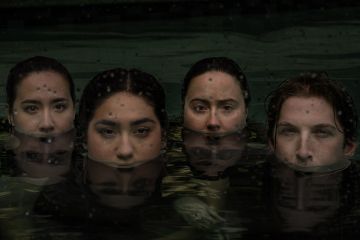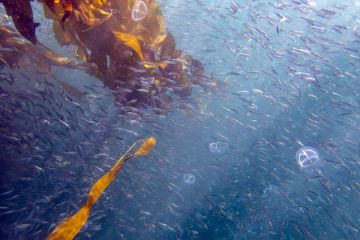Two UVic Scientists Join Voyage of Discovery in "Submarine Ring of Fire"
Billowing clouds of volcanic ash and molten sulphur, forests of "black smoker" chimneys up to nine metres tall, plumes of liquid carbon dioxide bubbles, and countless lifeforms that are likely new to science.
Sound like another world? In a sense it is. These are just a few of the remarkable, never-been-seen-before underwater spectacles that greeted UVic ocean scientists Dr. Verena Tunnicliffe and Dr. John Dower on a recent research cruise to the “Submarine Ring of Fire,” or Mariana Arc—a 1,200-km chain of volcanic seamounts and islands in the western Pacific between Guam and Japan.
Tunnicliffe and Dower were part of a 34-member expedition sponsored by the National Oceanic and Atmospheric Administration (NOAA) Ocean Exploration Program, a scientific and educational outreach program. The expedition used ROPOS—the Canadian submersible partly funded by UVic and housed in Sidney, B.C.—to explore hydrothermal sites and collect images and samples of vent fluids, unusual life forms, and mineral and volcanic rocks.
Tunnicliffe is a leading authority on deep sea life and the Canada Research Chair in deep ocean research. Dower has been studying physical-biological interactions in seamount ecosystems for the past 10 years. They and two other Canadian researchers represented the biology contingent on the cruise.
Among the many discoveries was an underwater volcano where sunlight-based and chemical-based ecosystems overlap. Images clearly show shallow-water reef fish swimming among black smoker chimneys. "This is the first place in the world where scientists have documented interactions between these two ecosystems," says Dower. "When they called this trip an exploration, they weren’t kidding."
Another surprise was how the life at every hydrothermal site differed. One was blanketed with barnacles, the next with limpets, and another with sponges. This contrasts with hydrothermal vents on the Juan de Fuca Ridge in the northeast Pacific which show comparatively little variation from site to site.
"These seamounts are key sites for fostering the importance of biodiversity in the oceans," says Tunnicliffe. "It was a wonderful trip. I’ve been to a lot of amazing places, but this reminded me how little we know about the oceans and that there are still a tremendous number of discoveries to be made."
A detailed expedition log, video and downloadable images are available on the expedition Web site at: oceanexplorer.noaa.gov/explorations/04fire/welcome.html.
Sound like another world? In a sense it is. These are just a few of the remarkable, never-been-seen-before underwater spectacles that greeted UVic ocean scientists Dr. Verena Tunnicliffe and Dr. John Dower on a recent research cruise to the “Submarine Ring of Fire,” or Mariana Arc—a 1,200-km chain of volcanic seamounts and islands in the western Pacific between Guam and Japan.
Tunnicliffe and Dower were part of a 34-member expedition sponsored by the National Oceanic and Atmospheric Administration (NOAA) Ocean Exploration Program, a scientific and educational outreach program. The expedition used ROPOS—the Canadian submersible partly funded by UVic and housed in Sidney, B.C.—to explore hydrothermal sites and collect images and samples of vent fluids, unusual life forms, and mineral and volcanic rocks.
Tunnicliffe is a leading authority on deep sea life and the Canada Research Chair in deep ocean research. Dower has been studying physical-biological interactions in seamount ecosystems for the past 10 years. They and two other Canadian researchers represented the biology contingent on the cruise.
Among the many discoveries was an underwater volcano where sunlight-based and chemical-based ecosystems overlap. Images clearly show shallow-water reef fish swimming among black smoker chimneys. "This is the first place in the world where scientists have documented interactions between these two ecosystems," says Dower. "When they called this trip an exploration, they weren’t kidding."
Another surprise was how the life at every hydrothermal site differed. One was blanketed with barnacles, the next with limpets, and another with sponges. This contrasts with hydrothermal vents on the Juan de Fuca Ridge in the northeast Pacific which show comparatively little variation from site to site.
"These seamounts are key sites for fostering the importance of biodiversity in the oceans," says Tunnicliffe. "It was a wonderful trip. I’ve been to a lot of amazing places, but this reminded me how little we know about the oceans and that there are still a tremendous number of discoveries to be made."
A detailed expedition log, video and downloadable images are available on the expedition Web site at: oceanexplorer.noaa.gov/explorations/04fire/welcome.html.
-- 30 --
Media contacts
Dr. Verena Tunnicliffe (Earth & Ocean Sciences) at (250) 721-7135 or 744-9471 or verenat@uvic.ca
Dr. John Dower (Earth & Ocean Sciences) at (250) 472-5010 or dower@uvic.ca
Valerie Shore (UVic Communications) at (250) 721-7641 or vshore@uvic.ca
In this story
Keywords: uvic, scientists, join, voyage, discovery, submarine, ring




